Cinco de Mayo at Talladega....and who will be celebrating Sunday afternoon?
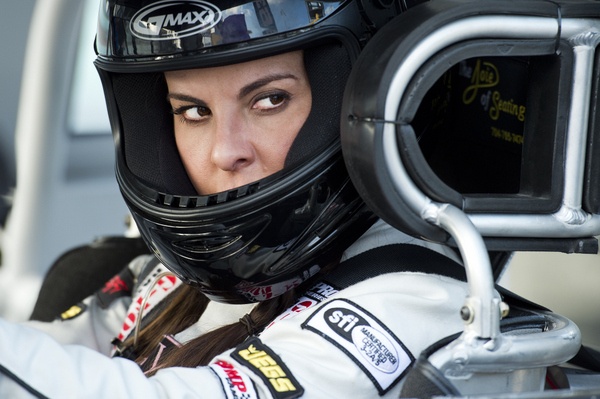
Ela at the wheel.....(Photo: Getty Images for NASCAR)
By Mike Mulhern
mikemulhern.net
TALLADEGA, Ala.
It's Cinco de Mayo, and NASCAR's hyper-energetic marketeers aren't letting this opportunity go to waste.
Say what you will about this sport's Sunday afternoon racing and officiating, and all those Tuesday/Wednesday/Thursday afternoon penalties and such, but the army marketing this sport is certainly on top of its game.
So Sunday night, after the Talladega 500, you can flip the TV to Channel Univision, turn on 'translation,' and get a gander of this sport's latest marketing pop to the increasingly important Hispanic audience (1015 pm ET)
Univision, which boasts the largest audience of Spanish-language TV viewers in the world, will televise a one-hour package of five-minute internet 'novellas' about NASCAR -- "Arranque de Pasion, La Historia de Ela."
That's roughly 'The start of passion, the story of Ela.'
...about a star NASCAR driver, female, who has been racing, and not so well, against her NASCAR boyfriend.
...and there's another guy too.
A NASCAR soap opera in Spanish....with Homestead-Miami Speedway the prominent stage.
Not sure if this is just an Hispanic version of Will Farrell and Talladega Nights or what. But it's starring a famous Mexican actress Kate del Castillo. To punch this thing up, she was the honorary starter for the California 400 in March.
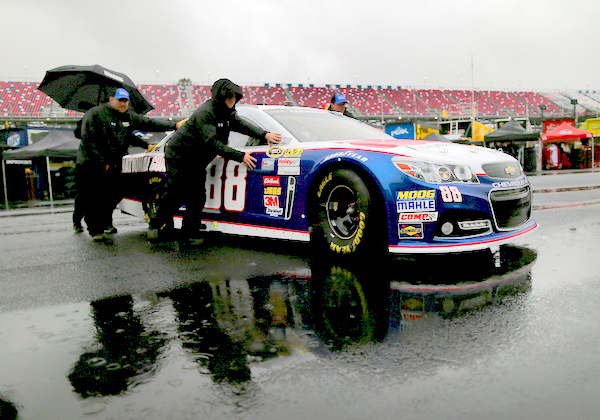
Springtime, and still a cold drizzle? What's up with this weather? (Photo; Getty Images for NASCAR)
Meanwhile down on the real playing field, for Chevy men Jimmie Johnson, Kasey Kahne and Dale Earnhardt Jr., things are going just great this spring.
But while Rick Hendrick's men keep on rolling, some of their toughest rivals -- Toyota's Matt Kenseth, Ford's Brad Keselowski and Toyota's Denny Hamlin -- are all reeling, with debilitating NASCAR penalties or, in Hamlin's case, a debilitating back injury.
Of course at this huge, wide-open track in the middle of Alabama, things can change in an instant.
Just ask Earnhardt.
He came in here last fall, midway through the playoffs, in good shape in the run toward the championship, enjoying one of the best seasons of his career.
And Earnhardt left here his season shattered.
No wonder he left in such a huff, to put it mildly, calling the racing here "bloodthirsty," and saying if he had to do this every week he'd find another job.
And that was before he'd realized he's just suffered another concussion in that last lap crash that Tony Stewart's block triggered. His second concussion in just six weeks. The concussion, on just a 20-G hit actually, that took him out of the Sprint Cup championship chase down the stretch of his best stock car season ever.
Last fall's 500 here was calm and uneventful until Stewart threw a third turn block on Michael Waltrip in a challenge for the lead on the final lap. Then all hell broke loose. Some 25 cars got caught up in the mess. Only four or so drivers were still running at the end, Matt Kenseth somehow slipping through the melee to win.
That race followed a vicious spring 500 here, in which Stewart, never one to hold his tongue, ripped the close-quarters battling with scathing, if sarcastic, words: "I'm sorry we couldn't crash more cars today. We didn't fill the quota for Talladega and NASCAR."
Ouch!
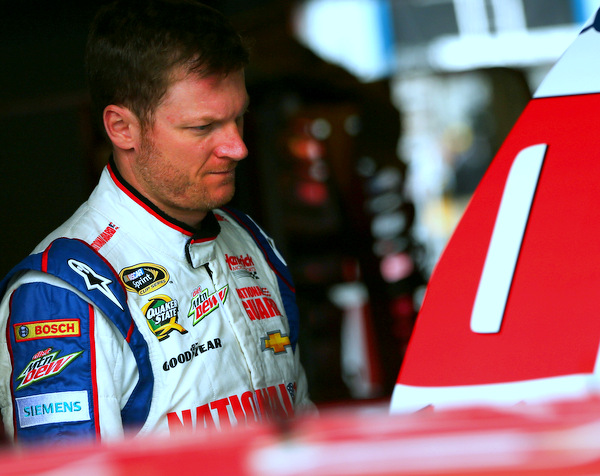
Dale Earnhardt Jr. (Photo: Getty Images for NASCAR)
Drivers, to be honest, have rarely if ever had that much fun racing at this track with restrictor plates creating such big packs and with the ever-present danger of 'The Big One.'
Despite the PR fluff drivers are forced to deliver....
"Even though you know it's really a lottery in some aspects, you still go in turning a blind eye to that part of it," Earnhardt says.
"Restrictor-plate racing is a race where you can get swept up in something totally out of your control, totally random, and at times ridiculous. You can be so frustrated by how out-of-your-hands that happens.
"When I got out of the car (here last October), I knew I had set myself back somehow with the concussion thing. I was really angry with that, because I had spent four weeks to get to where I could feel like I was great. And then 'Now I'm going to take two steps back and have to do all that again.'
"I was really, really mad that I couldn't just get through that wreck and not have that happen.
"I don't care if I'm in the crash and out of the race, but to get out of the car and feel concussed and feel like 'Oh, shoot, man. Now I've got to go through the process again,'.... and you're not supposed to have them (concussions) close together... and all this stuff and all kinds of worry running through your mind...."
And Earnhardt last vented all that.
Now he says he 'regrets' that venting.
Of course with NASCAR executives willing, perhaps even eager, to drop the hammer on anyone criticizing things in this sport these days, it's not clear how much of what any driver says is really how he feels.
Still, Earnhardt insists "I've regretted making those comments. I think I overreacted, and overstated my feelings quite a bit."
However he points out "It's frustrating when you spend all day running 495 miles and then crash in the last five.
"The whole field crashes.
"It's really frustrating to accept that as what I decided to do today: 'I got up Sunday morning and decided to run 495 miles to crash in the last five miles and now I'm going to go home and I'm all right with that.'
"That's hard to wrap your brain around."
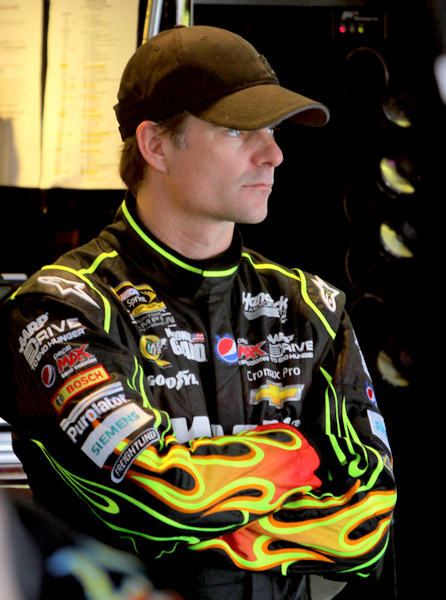
Jeff Gordon. (Photo: Getty Images for NASCAR)
Yet of course that is precisely the nature of this track, as a plate track, with huge packs.
NASCAR officials could change that dynamic of course if they wanted to. Remember the two-car packs? A lot safer racing. Rather intriguing too.
But NASCAR executives didn't like that, and they've gimcracked these cars specifically to keep them all in a big pack.
In return drivers have generally tended to deal with racing here in two different ways. Typically, for the past six or more years, maybe even longer, drivers really don't race that much the first 400 miles or so, except for show. Because they know even if they race cleanly all day, in the last corner of the last lap it can all go for naught.
Jeff Gordon: "At Talladega the only unknown is when that big wreck is going to happen and what's going to cause it...and sometimes it happens when you least expect it."
Hanging over Sunday's 500 here is the question of just what really did go on at Daytona two months ago, when drivers didn't/couldn't pass, and only the top lane seemed to work.
Will Sunday's 500 here be more of the same? Another single-file parade?
Gordon says probably so.
"It was hard to pass in Daytona....not that it's just hard to pass, it's that nobody wanted to get out of line. Everybody protected their position until those crucial moments in the closing laps. I think there could be some more of that this weekend."
So, let's ask the blunt question: is there any reason why this Talladega 500 should play out any differently than the Daytona 500?
Gordon bluntly replies "No."
Throw in some 'big picture' philosophy, with a look at the point standings and how the playoff cut might play out, and, well, you can do the math.
One of the 'tweaks' NASCAR has here, to prevent teams from tandem-drafting, is control of engine temperatures, so drivers can't hook up tightly for long stretches.
"You might be able to 'push' a little bit more aggressively (here Sunday, than at Daytona), and we'll look at the (engine) temps," Gordon says.
"But I think it's going to be just as challenging and difficult to jump out of line and to get a line formed on that inside to move up.
"It certainly could happen. And it could have happened at Daytona; it just didn't seem like enough guys really wanted to get organized to do it. They were pretty committed to stay in that outside lane.
"So it made it very challenging. And I would think you are going to see a lot more of the same here."
Which all leads to Denny Hamlin. He's making a comeback after five weeks on the sidelines recovering from that California crash.
Is Hamlin coming back too quickly, in his quest to get back in the championship race?
And why, really now, are NASCAR officials allowing such an injured driver to get back behind the wheel anyway? Are they abdicating too much of their responsibility here, in terms of safety...not only for Hamlin but for his fellow drivers?
Gordon says he has a different take on Hamlin's comeback here: "I probably would take a little longer vacation.
"He's young; he's got so many years ahead of him. I probably would be more patient with it just because what do I have to gain? I've had the fortune of winning four championships."
How to make that call, to race or sit out another week? NASCAR officials seem to be trying to pin that call on the driver and his doctors.
Gordon's view: "You have to put faith in your doctors and listen to them; they are the experts.
"Then you have to understand where you're at in your career.
"If you have many, many years ahead of you, then you have a bright future... and you have a team that supports you to get through that healing process... then you need to take your time and think long-term.
If you're somebody struggling to keep that ride, they are going to push the limits more and take that risk.
"Life in general is just risk-versus-reward. As a driver, we don't think of ourselves any more risky out there than somebody that has a nine-to-five job.
"So you have to take yourself out of that and understand what the dangers are, what the risks are -- and if you re-injure yourself, can that be life-threatening or something that ends your career.
"I'm later in my career, and have a family. So, an injury like what Denny went through, I don't know. I might not come back from that just because 'Is it worth it?'
"For Denny, I think it's worth it for him to really take his time and do it right."
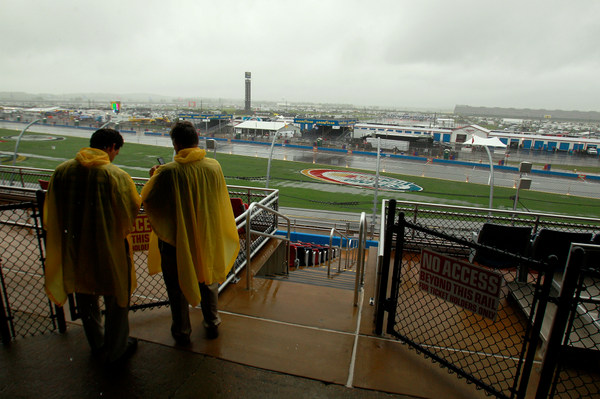
Not a great Saturday at the track. Hope Sunday is better (Photo: Getty Images for NASCAR)
© 2010-2011 www.mikemulhern.net All rights reserved.
Web site by www.webdesigncarolinas.com







4 week for a back fracture is not long enough
I know they have some very expensive antibody treatment to speed up the healing process, but 4 weeks just seems a bit too risky.
Post new comment